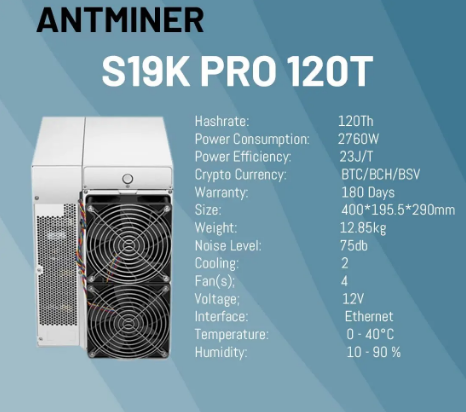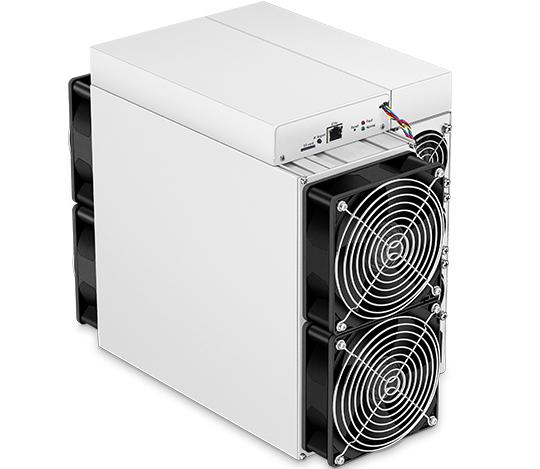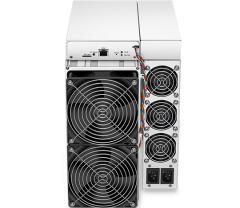How Much Electricity Does Bitcoin Miner S19k Pro Consume?
Cryptocurrency mining is an energy-intensive process, and understanding the electricity consumption of your mining hardware is critical to maximizing profitability. The Bitcoin Miner S19k Pro, developed by industry leader Bitmain, is one of the most advanced mining devices available today. This article dives deep into the electricity consumption of the S19k Pro, exploring its energy efficiency, operational costs, and real-world implications for miners.
Introduction to the Bitcoin Miner S19k Pro
The Bitcoin Miner S19k Pro is a high-performance ASIC miner designed for SHA256-based cryptocurrencies like Bitcoin (BTC), Bitcoin Cash (BCH), and Bitcoin SV (BSV). With a hashrate of 120 TH/s and a power efficiency of 23 J/TH, the S19k Pro stands out as one of the most efficient miners in its class.
Its robust design, compact size, and user-friendly features make it a popular choice for both individual miners and large-scale mining operations. However, its electricity consumption is a key factor that determines its overall profitability.

Understanding Electricity Consumption in Cryptocurrency Mining
Electricity consumption is one of the most significant expenses in cryptocurrency mining. Mining devices like the S19k Pro require substantial power to solve complex mathematical problems and validate transactions on the blockchain. The more efficient a miner is, the lower its electricity costs relative to the rewards it generates.
The S19k Pro’s power efficiency of 23 J/TH means it consumes 23 joules of energy to perform one terahash of computational work. To put this into perspective, older miners like the Antminer S9 consume around 98 J/TH, making the S19k Pro nearly four times more efficient.
Calculating the S19k Pro’s Power Consumption
To calculate the S19k Pro’s electricity consumption, we use the formula:
Power Consumption (Watts) = Hashrate (TH/s) × Power Efficiency (J/TH)
For the S19k Pro:
- Hashrate: 120 TH/s
- Power Efficiency: 23 J/TH
Power Consumption = 120 TH/s × 23 J/TH = 2,760 Watts
This means the S19k Pro consumes 2,760 watts (2.76 kW) of electricity during operation.
Daily, Monthly, and Annual Electricity Costs
To understand the financial impact of the S19k Pro’s electricity consumption, let’s calculate its daily, monthly, and annual costs based on an average electricity rate of $0.10 per kWh.
- Daily Cost:
- Power Consumption: 2.76 kW
- Hours of Operation: 24 hours
- Electricity Rate: $0.10/kWh
Daily Cost = 2.76 kW × 24 hours × $0.10/kWh = $6.62
- Monthly Cost:
Monthly Cost = $6.62/day × 30 days = $198.72

- Annual Cost:
Annual Cost = $198.72/month × 12 months = $2,384.64

These calculations highlight the importance of optimizing electricity costs to ensure profitability.
Comparing the S19k Pro to Other Miners
The S19k Pro’s energy efficiency sets it apart from many competitors. For example, the Antminer S19 Pro consumes around 3,250 watts with a power efficiency of 29.5 J/TH. While it offers a slightly higher hashrate (110 TH/s), its higher power consumption results in greater operational costs.
In contrast, the S19k Pro’s 23 J/TH efficiency makes it a more cost-effective option, especially in regions with higher electricity rates.
Operational Insights for Miners
1. Location Matters
Electricity costs vary significantly by region. Miners in areas with low electricity rates (e.g., $0.05/kWh) will see substantially lower operational costs compared to those in high-rate regions (e.g., $0.15/kWh).
2. Cooling and Environmental Factors
The S19k Pro operates optimally at temperatures between 0°C and 40°C. Excessive heat can reduce efficiency and increase power consumption. Investing in proper cooling systems is essential to maintain performance.
3. Renewable Energy Options
Many miners are turning to renewable energy sources like solar or wind power to reduce electricity costs. The S19k Pro’s efficiency makes it an ideal candidate for such setups.
4. Mining Pool Considerations
Joining a mining pool can help distribute electricity costs among participants, making it easier to achieve consistent returns.
Advantages of the S19k Pro’s Energy Efficiency
- Lower Operational Costs:
The S19k Pro’s 23 J/TH efficiency translates to reduced electricity bills, maximizing profitability for miners.
- Sustainability:
Its lower power consumption makes it a more environmentally friendly option, aligning with the growing demand for sustainable mining practices.
- Long-Term Viability:
As Bitcoin’s difficulty increases, energy-efficient miners like the S19k Pro remain profitable for longer periods, ensuring a future-proof investment.
- Scalability:
The S19k Pro’s efficiency allows miners to scale their operations without proportionally increasing electricity costs.
Real-World Applications
Case Study: Large-Scale Mining Farm
A mining farm with 100 S19k Pro units would consume approximately 276 kW of power. At $0.10/kWh, the daily electricity cost would be $662, or $19,860 per month. By switching to a more efficient miner like the S19k Pro, the farm could save thousands of dollars annually compared to using older, less efficient models.
Case Study: Home Miner
A home miner with one S19k Pro would spend $6.62/day on electricity. By optimizing their setup with efficient cooling and renewable energy, they could further reduce costs and increase profitability.
Conclusion
The Bitcoin Miner S19k Pro is a game-changer in the world of cryptocurrency mining, offering unparalleled energy efficiency and performance. With a power consumption of 2,760 watts and an efficiency rating of 23 J/TH, the S19k Pro minimizes operational costs while maximizing profitability.
For miners, understanding and optimizing electricity consumption is crucial to staying competitive in this rapidly evolving industry. By leveraging the S19k Pro’s advanced features, miners can achieve sustainable, profitable operations, whether they’re running a small home setup or a large-scale mining farm.

Investing in the S19k Pro is not just a step toward better mining efficiency—it’s a step toward a more sustainable and profitable future in cryptocurrency mining.